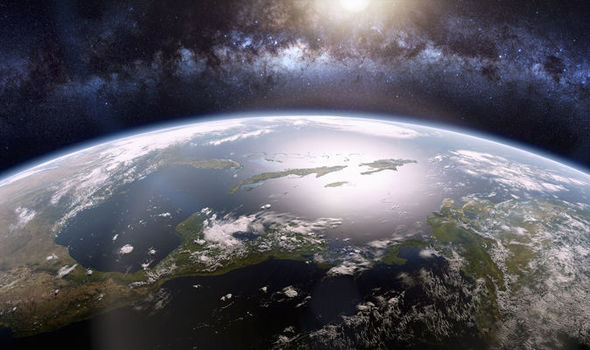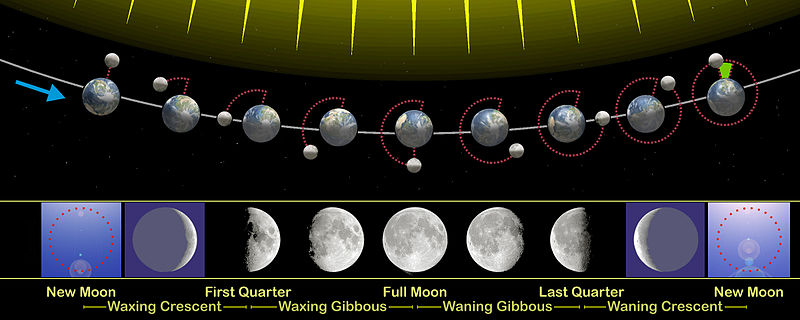Why The Earth Is Round
Debunking the biggest conspiracy theory on the globe

January 31, 2018
Throughout time, great thinkers and scientists such as Plato, Aristotle, Pythagoras, Archimedes, and Eratosthenes have proven that the Earth is round. However, seeing as there are still people who believe that the Earth is flat, they must not have done a very good job. Here at the BHS Blueprint, we’ve decided to take matters into our own hands and prove once and for all that the Earth is round.
A few reasons why the Earth is not flat:
1. The sun rises and sets.
According to the Flat Earth Society, the largest flat-earth association on the globe, the Sun and the Moon orbit like this:

This appears logical (other than the fact that the sun does not rise in the northeast, dip way south, and set in the northwest, and the fact that the sun shouldn’t shine light in an oval shape, and the fact that Antarctica isn’t shaped like that, and the fact that if you fly east, you don’t run into South America), but there’s a problem: it doesn’t explain how the sun sets. As you probably know, at the end of the day, the sun disappears beneath the horizon in a phenomenon called sunset. This phenomenon has been captured on video numerous times. Here is an example:

As you can see in this time-lapse video, the sun sinks beneath the horizon, leaving the Earth dark. This is what creates night. In order for an actual sunset to happen in a flat earth, the sun would have to disappear beneath the surface of the Earth, meaning that the entire planet would be dark. As we know, this is not the case; some parts of the Earth are bright while others are dark. For evidence of this, here are links to live videos of Amsterdam, Dubai, and Perth. As you can see, it is a different time of day in all of those places. Therefore, the Earth can not be flat, because if it were, the sun would set at the same time over the entire Earth.
Several flat-earthers have suggested that the sun works like a flashlight, only directing light over a certain part of the earth at a time, like so:

This conception of day and night does not explain how the sun sets. If this lamp-sun conception were the case, you would be able to see the sun during the night. Its light just wouldn’t be shining on you. The sun would never set, because it would never drop below the horizon.
Another argument that flat-earthers have made is that the sun is only a few miles above the surface of the Earth and rotates around in a similar way to the animation above. The problem with this model is that the sun would remain extremely close to the horizon for most of the day, and that it would still be partially visible at night.
If the earth is flat, there is no explanation for why a) the sun sets and b) different parts of the earth are lit up at different times. Different arguments can explain one or the other, but no argument can explain why both of those phenomena occur.
2. There are lunar eclipses.
As you probably know, every month, the moon goes through a cycle in which the shape of its illuminated portion changes from new (not illuminated) to full (completely illuminated) to new again. This happens because as the moon rotates around the Earth, different amounts of it are illuminated by the sun, like so:

Such phases of the moon are impossible on a flat earth, because in order for the moon to be full, the sun would have to be on the other side of the Earth. As we’ve been over before, if the sun were on the other side of a flat earth, it would mean that the entire Earth would have to be dark. This never happens.
In response to this, several flat-earthers have claimed that the moon is self-illuminating, meaning that it shines on its own and that moonlight is not a reflection of sunlight. According to these flat-earthers, half of the moon is bright and half of it is dark. The moon rotates, creating the lunar phases.
The self-illuminating moon theory does not explain one major phenomenon: the lunar eclipse.
It’s tough to explain why a self-illuminating moon would all of a sudden go dark, or for why whenever it goes dark, it’s during a full moon. Here are some possible explanations:
- During lunar eclipses, the moon is blocked out by the lost planet Nibiru.
- The moon is a scam created by NASA; the lunar eclipses happen when NASA replaces the batteries.
- There are no real “lunar eclipses” – it’s just a trick of the light.
There are no logical explanations for why lunar eclipses happen. Lunar eclipses, therefore, invalidate the self-illuminating moon argument and, with it, the flat-earth argument.
Disproving other flat-earth arguments

Sigh… gravity pulls us towards the center of the earth, not south.

And everything that I’ve mentioned so far in this article. And much, much more.

We can’t feel the Earth moving because it is in equilibrium. Get in a car, go on a highway, and get up to 60 miles per hour. Then stop accelerating. Even though you’re going 60, it will feel like you’re not moving at all. It’s the same thing with the Earth. And we can, in fact, see the Earth’s curvature. It’s very slight, but still visible, especially if you look at a large body of water.


